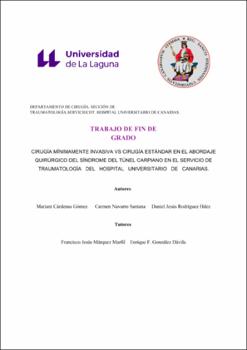Cirugía mínimamente invasiva vs cirugía estándar en el abordaje quirúrgico del síndrome del túnel carpiano en el servicio de traumatología del Hospital Universitario de Canarias
Fecha
2019Resumen
Introducción: El Síndrome del Túnel Carpiano (STC) está causado por la compresión del nervio
mediano dentro del ligamento anular del carpo. Síntomas incluyen entumecimiento, hormigueo, ardor
o dolor en la zona inervada por el nervio mediano.
Objetivo: Comparación entre 2 incisiones quirúrgicas; incisión estándar (SS) y mínimamente invasiva
(MIS), mejoría sintomatológica y funcional postquirúrgica a corto plazo.
Material y Método : En este estudio prospectivo contamos con 14 manos diagnosticadas de STC
mediante electromiografía y sintomatologicamente . Fueron sometidos a tratamiento quirúrgico por el
mismo traumatólogo (empleando la misma técnica en los pacientes del mismo grupo) entre enero y
mayo de 2019. Se entregaron cuestionarios precirugía, 4 y 8 semanas tras intervención, estos
son: Dash, Boston, SF-36. Fueron citados 1 y 2 semanas postquirúrgicas para observar
evolución de herida, dolor o calambres.
Resultados: La muestra conformada por 12 pacientes (14 manos), 7 (50%) intervenidos
mediante la MIS y el resto (50%) SS. El 14,2% (2 pacientes) tenían STC bilateral y fueron
intervenidos de ambas manos, realizando incisiones diferentes en cada mano.
Las encuestas Dash y SF36 no dieron resultados significativos entre cirugías ( Dash (p=0,297)),
pudimos comprobar evolución lineal en ambos casos.
Según Boston, hay disminución rápida entre prequirúrgico y primer mes (p=0,013),
estabilizandose posteriormente. no diferencias en evolución en función de incisión (p=0,28).
Conclusiones: Objetivamente y subjetivamente los resultados de MIS son superiores a los obtenidos
por SS. Sin embargo, la muestra es insuficiente para conseguir diferencias significativas entre
grupos. Introduction: Carpal tunnel syndrome (STC) is caused by compressión of median nerve inside annular
carpal ligament. Symptoms include numbness, tingling, pain and/or burning in area enervated by
median nerve.
Objective: To compare different surgical methods; standard incision (SS) and minimally invasive
incision (MIS) and see which had larger improvement in terms of symptoms and functionality in short
span of time.
Material and methods: Prospective cohort study included 14 hands diagnosed with STC by
electromyography and symptoms. Subjects in our study were operated by same traumatologist
using same surgical methods from January through May. Data acquired came mainly from
questionnaires given out before, 4 and 8 weeks after surgical procedures. Patients were cited 1
and 2 weeks post procedure to examine healing process and pain endured during that time.
Results: Study group counted with 12 patients (14 hands); 7 (50%) underwent MIS procedure
and the other 7 (50%) SS procedure. 2 patients (14,2%) underwent both procedures (different
procedure in each hand). Dash and SF36 questionnaires did not give significant differences
between procedures ( DASH (p=0,297)). However, we were able to find a lineal evolution in
both cases, patients kept improving after checkups.
Boston questionnaire rapidly declined pre surgery to 1 month post surgery (p=0,013), no
evolutionary changes between incisions (p=0,28)
Conclusions: Better results were obtained objectivably and subjectivably in MIS procedure.
Nonetheless, sample shows better outcome with minimally invasive surgery procedure (MIS)
but more data is needed.





